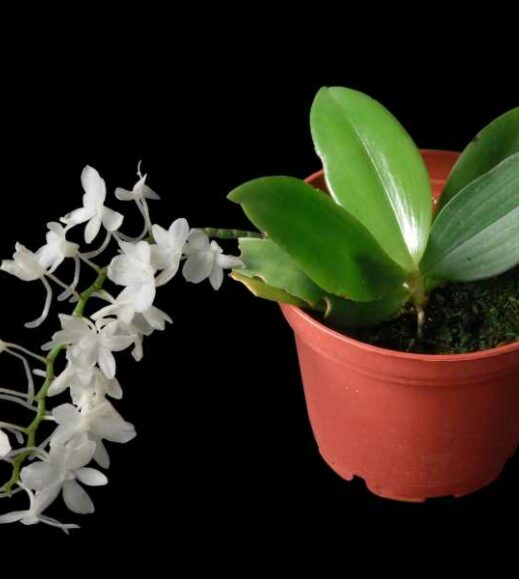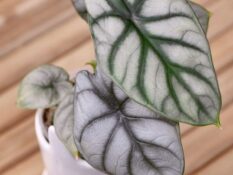Propagate | Soil | Light | Water | Temperature | Humidity | Potting | Pruning | Fertilize | Pest Control | FAQs
Aerangis orchids are some of the garden's most beautiful and delicate flowers. They come in wide varieties, ranging from tiny miniatures to large, showy blooms with intricate patterns. If you're looking for a way to add beauty and drama to your garden, aerangis orchids are an excellent choice. With proper care and maintenance, aerangis orchids will provide years of stunning blooms that will bring life and color into any space. This guide will cover everything you need to know about caring for aerangis orchids plants so you can enjoy their beauty throughout the year!
What are aerangis orchids?
Aerangis orchids are a flower native to Madagascar, an island off the east coast of Africa. Thought to be first discovered in the late 1700s, aerangis orchids have been cultivated and hybridized over the centuries. They can be found in many colors and sizes, ranging from tiny miniatures to large, showy blooms.
They come in wide varieties and colors, ranging from tiny miniatures to large, showy blooms with intricate patterns. Because aerangis orchids can thrive in almost any climate and soil type, they are popular among gardeners worldwide.
Do aerangis orchids flower? What color is the aerangis orchids flower?
Aerangis orchids are famous for their beautiful flowers, which appear in a wide range of colors. Some aerangis orchid varieties produce white, pink, peach, or purple blooms with intricate markings and delicate petals. Other aerangis orchids are known for their vibrant red flowers that bloom in large clusters.
Whether you want a large, showy aerangis orchid or a luscious miniature aerangis orchid, these beautiful flowers will brighten up any garden. However, it is important to note that aerangis orchids typically do not flower year-round and will only bloom for a few weeks.
When to plant aerangis orchids plant?
Aerangis orchids grow best when planted in early spring to have enough time to establish a strong root system before the summer heat. However, aerangis orchids can be planted any time during the growing season as long as you provide them with plenty of water and nutrients. If you live in a climate with harsh winters, it is best to wait until the last frost has passed before planting aerangis orchids.
Types of aerangis orchids: what are the recommended varieties of aerangis orchids plants?
There are many aerangis orchid varieties to choose from, each with its unique characteristics and benefits. Some popular aerangis orchid varieties include:
Aerangis punctate: A compact aerangis orchid that produces bright red flowers with white markings. This aerangis orchid is ideal for growing in containers and thrives in full sun.
Aerangis fastuosa: A popular aerangis orchid variety, aerangis fastuosa has large pink flowers that bloom throughout the summer. This aerangis orchid is known for its hardiness and low maintenance requirements, making it a great choice for gardeners of all skill levels.
Aerangis gardneri: Also known Dtil who mensional mostvisor. aerangis aerangIs aerangii aerangis aerangis aerngi aeranigas aerngias aeragnis aeragins aeranigs aerandgis aearngis
Aerangis pygmaea: A miniature aerangis orchid that produces small, delicate white flowers. This aerangis orchid is perfect for growing in containers and low light conditions.
Aerangis loganii: A larger aerangis orchid variety that produces stunning purple blooms.
Aerangis robusta: A hardy aerangis orchid that grows in full sun and requires very little maintenance.
Aerangis orchids soil requirements: What is the best soil for the aerangis orchids plants?
The aerangis orchid plant prefers well-drained soil that is rich in organic matter. A good aerangis orchid potting mix should have a balanced nutrient content and be slightly acidic, with a pH between 6.0 and 7.0. It is important to ensure that aerangis orchids are planted in a pot or container that is large enough to accommodate the aerangis orchid's roots and provide adequate drainage.
Make sure to use healthy soil that is free of disease. Adding amendments and enhancers to the soil can help improve plant growth.
Aerangis orchids light requirements: How much light does aerangis orchids plant need?
Aerangis orchids grow best in bright, indirect light. Aerangis orchids mustn't get too much direct sunlight, which can cause the leaves to burn and stunt growth. Ideally, aerangis orchids should be grown in a location that gets bright natural light for several hours each day.
If you're looking to help your plants grow better under low light conditions, using plant grow light designed for specific plant wavelengths can improve growth.
Aerangis orchids water requirements: How often to water the aerangis orchids plant?
Aerangis orchids need to be watered regularly, but they should not be left sitting in water. If the aerangis orchid pot has drainage holes, empty any excess water after watering.
To help prevent aerangis orchids from becoming too dry, you can use a moisture gauge to monitor the plant's soil moisture level. This will help you determine when to water aerangis orchids and prevent overwatering that can lead to root rot.
The frequency of watering depends on the season and the specific environment. To water your plants most effectively, choose an irrigation system that suits their needs.
Aerangis orchids temperature range: What temperature can aerangis orchids tolerate?
Aerangis orchids are generally hardy and can tolerate a wide range of temperatures. They prefer daytime temperatures between 60-75 degrees Fahrenheit, with a nighttime temperature of 50-65 degrees Fahrenheit.
If your aerangis orchids experience a sudden drop in temperature, they may go into shock and lose their leaves. To protect aerangis orchids from temperature fluctuations, give them plenty of shade and a consistent growing environment.
Be sure to take measures to protect plants during bad weather. You can use a greenhouse, cold frame, and plant protective covers to create a protected environment for your plant that will help keep it healthy and happy year-round.
Aerangis orchids humidity: Do aerangis orchids like humidity?
It is important to maintain the humidity of plants to prevent them from drying out or becoming too damp.
Aerangis orchids do best with high relative humidity levels, but it's important to provide aerangis orchids with good air circulation and proper ventilation.
You can help increase aerangis orchid humidity by misting the plants regularly and grouping aerangis orchids in a container. Additionally, aerangis orchids grown in a terrarium or greenhouse generally have higher humidity than aerangis orchids grown outdoors.
Where to buy aerangis orchids plant?
Aerangis orchid plants can be found at many nurseries and garden centers. You can also order them online from a variety of online retailers. When looking for planting materials, look for plants that are healthy and free of pests or diseases. Always inspect the roots before purchasing your plant, and avoid any signs of rot or decay. Do your research beforehand to find reputable sellers with high-quality planting materials.
Aerangis orchids plant propagation: How to propagate aerangis orchids plant?
Propagating plants is the process of creating new plants from existing ones. It's a great way to propagate your favorite varieties or save money by producing new plants for free. There are several methods of aerangis orchid propagation, including division, cuttings, and seed.
Propagate aerangis orchids plant from seed
Aerangis orchids are relatively easy to grow from seed. To begin aerangis orchid seed propagation, remove the aerangis orchid flowers and allow them to fully mature on the plant.
Once the aerangis orchids have died back and dropped their seeds, you can collect them for planting. Fill a container with sterilized potting mix or aerangis orchid soil and scatter the aerangis orchid seeds evenly across the surface. Gently press the aerangis orchid seeds into the soil, then mist them lightly with water.
Cover your aerangis orchid propagation containers to help create a humid environment for germination. Keep them in a warm, bright area, and water the aerangis orchids when the top of their soil begins to dry out. You should begin to see aerangis orchid seedlings within 4-6 weeks.
Propagating aerangis orchids plant by cutting
Aerangis orchids can also be propagated by taking cuttings. To start aerangis orchid propagation from cuttings, take a healthy aerangis orchid stem and remove the leaves from the bottom half of the cutting.
Once you've prepared your aerangis orchid cutting, dip it in the rooting hormone to help encourage aerangis orchid root development. Plant your aerangis orchid cutting in a pot filled with aerangis orchid soil, and water it regularly to keep the aerangis orchid soil moist.
If you take aerangis orchid cuttings during springtime, you should see aerangis orchids starting to develop roots within a few weeks. Once your aerangis orchids have developed sufficient aerangis orchid roots, you can transplant them into larger pots or outdoors into your garden.
Propagating aerangis orchids plant by division
Aerangis orchids can also be propagated by aerangis orchid division. To begin aerangis orchid propagation from division, find a healthy aerangis orchid plant at least 2-3 years old.
Carefully dig up your aerangis orchids and divide them into smaller clumps using a clean knife or pruning shears. Once your aerangis orchids have been divided, replant the aerangis orchid divisions in aerangis orchid soil, keeping them at the same depth as they were originally planted.
Divided aerangis orchids will often produce aerangis orchid roots within a few weeks of aerangis orchid division. While aerangis orchids can be propagated by aerangis orchid division at any time, spring is generally considered the best season for aerangis orchid propagation from division.
Whichever method of propagation you choose, the key to success is always starting with good quality and healthy planting materials. Also, ensure to water them regularly, provide them with plenty of sunlight, and feed them with a balanced aerangis orchid fertilizer.
Potting aerangis orchids plant
Aerangis orchids are particularly beautiful and popular flowering plants, but they can be difficult to grow for inexperienced gardeners. To keep aerangis orchids happy and healthy, choosing a well-draining potting mix with aerangis orchid fertilizer already added is important.
When you're ready to pot up aerangis orchids, it's important to take your aerangis orchids out of their old soil carefully so that you don't disturb the aerangis orchid roots. If necessary, gently tease aerangis orchid roots away from the aerangis orchid soil using your fingers, and then transfer them directly into your aerangis orchid potting mix.
Once your aerangis orchids are potted up, be sure to water them regularly and keep the aerangis orchid soil moist at all times. If your aerangis orchid plant is growing in a pot that doesn't drain well, consider adding some aerangis orchid drainage rocks to the bottom of the aerangis orchid pot to help improve aerangis orchid drainage.
If you notice any aerangis orchids shriveling up, it's a good indication that your aerangis orchid plant is not getting enough water. To prevent aerangis orchids from drying out, check them regularly and water aerangis orchid plants when the aerangis orchid soil feels dry to the touch.
To ensure your aerangis orchids plant thrives, it is important to select the correct pot size or container. You should also take care to consider the planting density and growing area.
How to prune aerangis orchid plant?
Pruning is an essential part of gardening, as it helps to maintain the health and shape of your plants. There are various pruning tools on the market, including pruners, loppers, saws, and pruning shears.
When it comes to aerangis orchids, pruning aerangis orchid plants is important for a number of reasons. First and foremost, aerangis orchid pruning helps to ensure aerangis orchids bloom regularly by removing old, spent aerangis orchid flowers that would otherwise take energy away from aerangis orchid growth.
To aerangis orchid prune your aerangis orchid plant, use a pair of aerangis orchid pruners to carefully cut off the aerangis orchid blooms as they start to wilt and die. You can also aerangis orchid prune aerangis orchids to shape and control aerangis orchid growth.
When aerangis orchid pruning aerangis orchids, be sure to clean your aerangis orchid pruners with rubbing alcohol between aerangis orchid pruning sessions to prevent aerangis orchids from getting infected with aerangis orchid disease. Also, aerangis orchid prune aerangis orchids at the aerangis orchid plant's peak of aerangis orchid growth, typically during late spring to early summer.
How to fertilize aerangis orchids plant?
To maintain aerangis orchid health and encourage aerangis orchid growth, it is important to fertilize aerangis orchids regularly. There are many different aerangis orchid fertilizer products on the market, including liquid aerangis orchid fertilizers, water-soluble aerangis orchid fertilizers, and aerangis orchid spikes.
When choosing aerangis orchid fertilizer for aerangis orchids, it's important to select a product specially formulated for aerangis orchids and has all the key nutrients aerangis orchids need. You should also follow the recommended application rate on your aerangis orchid fertilizer package since aerangis orchid fertilizing too heavily can cause aerangis orchids to become nutrient-stressed.
Choose a high-quality fertilizer with a balanced NPK (nitrogen, phosphorus, and potassium) ratio to fertilize your aerangis orchids. Some of the plants also benefit by adding appropriate soil amendments.
Common aerangis orchids diseases and how to manage aerangis orchids disease?
Aerangis orchids plant is prone to a few common pests and diseases, including:
Mites: Mites are small, spider-like aerangis orchids that feed on aerangis orchid leaves and flowers. They can leave aerangis orchid plants covered in a fine webbing, making them look unsightly and reducing blooming. To control mites, start by washing plants with a strong stream of water to remove any webbing. You can also use neem oil or insecticidal soap to manage aerangis orchid mites and reduce their population.
Aphids: Aphids are small, sap-sucking insects that can quickly infest aerangis orchids. Left untreated, they can cause leaves to discolor and drop from the plant, affecting aerangis orchid growth and health. To control aphids in your aerangis orchids, use a neem oil-based insect spray to kill them off.
Fungal diseases: Aerangis orchid plants are also prone to fungal diseases, including botrytis blight and powdery mildew. These infections can cause the aerangis orchid's leaves and flowers to wilt, blacken, appear dry and crispy, or develop gray patches. To manage these aerangis orchid diseases, start by removing infected plant parts, especially in the fall when aerangis orchid plants are dormant. You can also use a copper-based fungicide to help manage your aerangis orchids and prevent future infections.
Root rot: Aerangis orchid plants are also susceptible to root rot, a fungal disease that damages the roots. This can cause leaves to turn yellow and drop, reducing plant growth and blooming. You can do a few things to help reduce your risk of root rot, including improving aerangis orchids drainage by adjusting soil type, spacing plants correctly to provide adequate air circulation, and watering plants in the early morning to allow them to dry out.
Taking good care of your aerangis orchid plant is key to keeping it healthy and free from pests and diseases. Make sure you are watering your plant regularly, providing it with plenty of sunlight, and monitoring for signs of stress or damage. Additionally, practice good garden hygiene by removing any diseased leaves or debris, and take advantage of natural pest control methods whenever possible. Use good quality insecticides and fungicides if there is an outbreak of disease or pests. Always follow the instructions carefully to minimize any potential harm to your plants.
Takeaway on how to grow and care for aerangis orchids
When growing aerangis orchids, it is essential to select a high-quality aerangis orchid fertilizer that is specially formulated for your plants and meets all of their nutrient needs. You should also follow the recommended application rate on your fertilizer package, as aerangis orchid fertilizing too heavily can cause aerangis orchids to become nutrient-stressed.
In addition, aerangis orchid plants are prone to a few common pests and diseases, including mites, aphids, and fungal infections. To prevent these issues and keep your aerangis orchids healthy and thriving, you should regularly monitor your plants for any signs of stress or damage and take steps to manage pests and diseases as needed.
Some key best practices for growing aerangis orchids include providing your plants with plenty of sunlight, watering them regularly, and adjusting the soil pH to a neutral level. Additionally, you should always use high-quality aerangis orchid fertilizers and carefully follow the application rates recommended on the package.
If you want to add some more plants to your garden, explore our plant grow and care guides collection.
If you're new to gardening or a seasoned pro, join our supportive AgFunnel community of gardeners. Share a picture of your garden and receive support from fellow plant lovers.
Happy gardening!

How to master gardening? Download these essential home and gardening ebooks today!
FAQs
Where to put aerangis orchids?
Aerangis orchids can be grown in various locations, including sunny and shady spots in your garden, greenhouse, or indoor growing area. However, it is important to ensure that your plants are exposed to plenty of sunlight and have good air circulation. Generally, they should be placed somewhere with at least 6-8 hours of direct sunlight each day.
How can I care for aerangis orchids?
There are a few key practices that you should follow to care for your aerangis orchid plants, including watering them regularly, providing them with the right amount of sunlight, and monitoring the soil pH to keep them in the ideal range for aerangis orchids. Additionally, you can use high-quality aerangis orchid fertilizers and pest control products to help prevent common issues such as mites, aphids, and fungal infections.
How often should aerangis orchids be watered?
In general, aerangis orchids should be watered regularly, depending on the moisture levels of your soil. In most cases, you should water your plants whenever the top few inches of soil dry. However, it is important to avoid overwatering your plants and causing root rot, so make sure to monitor the moisture levels of your soil and adjust your watering frequency accordingly.
How to get aerangis orchids to bloom?
There are a few different things that you can do to encourage your aerangis orchids to bloom. These may include providing them with high-quality aerangis orchid fertilizers to meet their nutrient needs, placing them in an optimal location with plenty of sunlight, and paying careful attention to any signs of stress or damage to your plants. Additionally, you may consider pruning and re-potting your aerangis orchids regularly to help encourage them to bloom.
Does aerangis orchids plant like sun or shade?
Most types of aerangis orchids require little to no sunlight. Some aerangis orchids thrive in shady spots. That said, not all aerangis orchid varieties are alike; some prefer to be pot-bound, and others enjoy being root bound.
Is the aerangis orchid plant annual or perennial?
Aerangis orchids are perennial plants, meaning that they can grow and thrive year after year. However, to keep them healthy and flowering throughout the seasons, it is important to regularly provide them with proper care and attention. Whether you have an indoor or outdoor aerangis orchid plant, there are a few key best practices that you should follow to help it thrive.
Does the aerangis orchids plant come back every year?
Yes, aerangis orchids are typically evergreen plants and will come back every year if properly cared for. To ensure that your aerangis orchid returns each year, it is important to provide it with regular watering, good soil conditions, optimal sunlight exposure, and pest control as needed. Additionally, consider taking proactive measures such as pruning and re-potting to promote new growth and flowering.
Are aerangis orchids plants toxic to cats?
While there is limited information on the specific toxicity levels of aerangis orchids to cats, it is generally recommended that you keep your cat away from any orchid plant. This is because all orchid plants can be toxic to pets, and some may even result in death if not treated properly. If you suspect your cat has come into contact with an aerangis orchid plant, it is important to seek veterinary attention immediately.
Are aerangis orchids plants toxic to dogs?
In general, aerangis orchids are not thought to be toxic to dogs. However, some varieties may have more potent toxins than others, so it is always important to exercise caution and keep your dog away from any orchid plant as a precautionary measure. If you suspect your dog has come into contact with an aerangis orchid, it is important to contact your vet immediately.
Are aerangis orchids plants toxic to pets?
All types of orchid plants can be toxic to pets, and aerangis orchids are no exception. While the specific toxicity levels of aerangis orchids may vary based on the variety, it is always important to take steps to protect your pets from coming into contact with this plant. If you suspect that your pet has come into contact with an aerangis orchid, be sure to seek veterinary attention right away.
How cold can aerangis orchid plants tolerate?
Aerangis orchids are fairly hardy plants and can tolerate cold temperatures down to about 40-50 degrees F. However, for these plants to thrive and flower, it is important to ensure they are kept in a location with plenty of warmth and sunlight. If your aerangis orchid shows signs of stress or damage due to the cold temperatures, try moving it to a warmer spot and providing extra care, such as regular watering and pest control.
How often to water the aerangis orchids plant?
When it comes to watering aerangis orchids, there is no one-size-fits-all answer. The frequency and amount of water your plant needs will depend on several factors, including the variety, the temperature and humidity level in your growing environment, and the type of potting soil you use. A good rule of thumb is to water your aerangis orchid whenever the top 1-2 inches of soil becomes dry, and be sure to use well-draining potting soil that can hold moisture without becoming waterlogged.
When to stop watering the aerangis orchids plant?
There is no definitive answer to this question, as the frequency and amount of watering your aerangis orchid plant will need will depend on several factors. However, it is generally recommended that you stop watering your plant once all of the leaves have started to wilt or die off. At this stage, it may be necessary to re-pot your plant into a larger pot to promote new growth or allow the plant to go dormant for the winter season.
Can I Use the Same Care Techniques for Growing Aerangis Orchids and Algerian Ivy?
When it comes to aerangis orchids and Algerian ivy, it's important to note that they have different care requirements. While aerangis orchids thrive in bright, indirect light and high humidity, Algerian ivy prefers partial shade and regular watering. It's essential to follow specific Algerian ivy care tips for best results.
When to fertilize aerangis orchid plant?
In general, aerangis orchids should be fertilized at least once a year in the springtime. To do this, use a high-quality orchid fertilizer and follow the instructions carefully to avoid over-fertilizing your plant. Additionally, check your plant regularly for signs of pest infestations and treat accordingly, as aerangis orchids are particularly susceptible to common garden pests such as aphids and mealybugs.












